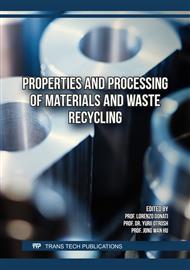[1]
World Health Organization: WHO. (2019, June 18). 1 in 3 people globally do not have access to safe drinking water – UNICEF, WHO. World Health Organization. https://www.who.int/news/item/18-06-2019-1-in-3-people-globally-do-not-have-access-to-safe-drinking-water-unicef-who
DOI: 10.2165/00151234-200605170-00032
Google Scholar
[2]
7Associated Press. (2015, March 22). UN Report: World faces 40% water shortfall by 2030. Voice of America. https://www.voanews.com/a/un-report-world-faces-40-percent-water-shortfall-by-2030/2690205.html
Google Scholar
[3]
Mangosing, O.R.P., Ang, H. J.T., Galarrita, K.M. a. L., Sable, S.J.R., Ucab, P.M.L., Cascon, H. R., Cabaraban, M. T. I., & Tan, N. P. B. (2023). Techno-economic analysis on the production of domestic water using solar-driven membrane seawater desalination device in the Philippines. Case Studies in Thermal Engineering, 41, 102575
DOI: 10.1016/j.csite.2022.102575
Google Scholar
[4]
Tan, N.P.B., Ucab, P.M.L., Dadol, G.C., Jabile, L.M., Talili, I.N., & Cabaraban, M.T.I. (2022). A review of desalination technologies and its impact in the Philippines. Desalination, 534, 115805
DOI: 10.1016/j.desal.2022.115805
Google Scholar
[5]
E. Chiavazzo, M. Morciano, F. Viglino, M. Fasano and P. Asinari, "Passive solar high-yield seawater desalination by modular and low-cost distillation," Nature Sustainability, vol. 1, pp.763-772, 14 December 2018.
DOI: 10.1038/s41893-018-0186-x
Google Scholar
[6]
Shahriar Habib;Steven T. Weinman; (2021). A review on the synthesis of fully aromatic polyamide reverse osmosis membranes . Desalination, (), –
DOI: 10.1016/j.desal.2021.114939
Google Scholar
[7]
Brami, M.V., Oren, Y., Linder, C., & Bernstein, R. (2017). Nanofiltration properties of asymmetric membranes prepared by phase inversion of sulfonated nitro-polyphenylsulfone. Polymer, 111, 137–147
DOI: 10.1016/j.polymer.2017.01.048
Google Scholar
[8]
Sandoval-Olvera, I. G., Villafaña-López, L., Reyes-Aguilera, J. A., Ávila-Rodríguez, M., Razo-Lazcano, T. A., & González-Muñoz, M. P. (2017). Surface modification of polyethersulfone membranes with goethite through self-assembly. DESALINATION AND WATER TREATMENT, 65, 199–207
DOI: 10.5004/dwt.2017.20302
Google Scholar
[9]
Ana, P. M., & Catherine, S. (2013b). Report of an interlaboratory comparison from the European Reference Laboratory for Food Contact : ILC002 2013 - Identification of polymeric materials. JRC VALIDATED METHODS, REFERENCE METHODS AND MEASUREMENTS
Google Scholar
[10]
Salunkhe, P. H., Ankushrao, S. S., Patil, Y. S., Mahindrakar, J. N., Kadam, V., Ubale, V. P., & Ghanwat, A. A. (2018b). Processable heat resistant polyamides containing tetraphenyl thiophene having pendant phenyl moiety with heterocyclic quinoxaline unit: Synthesis and characterization. Journal of Macromolecular Science, Part A: Pure and Applied Chemistry, 55(4), 377–383
DOI: 10.1080/10601325.2018.1444418
Google Scholar
[11]
M. Hirose, H. Ito, Y. Kamiyama, Effect of skin layer surface structures on the flux behaviour of RO membranes, J. Membr. Sci. 121 (1996) 209–215.
DOI: 10.1016/s0376-7388(96)00181-0
Google Scholar
[12]
A.K. Ghosh, B.H. Jeong, X.F. Huang, E.M.V. Hoek, Impacts of reaction and curing conditions on polyamide composite reverse osmosis membrane properties , J. Membr. Sci. 311 (2008) 34–45.
DOI: 10.1016/j.memsci.2007.11.038
Google Scholar
[13]
Alkhudhiri, Abdullah (2018). Emerging Technologies for Sustainable Desalination Handbook || Membrane distillation—Principles, applications, configurations, design, and implementation., (), 55–106
DOI: 10.1016/B978-0-12-815818-0.00003-5
Google Scholar



